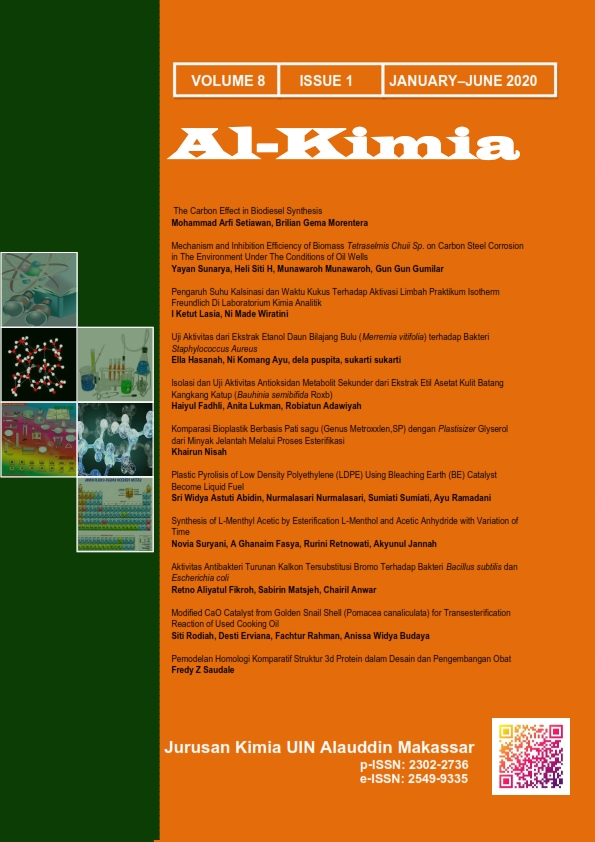Mechanism and inhibition efficiency of biomass Tetraselmis chuii sp. on carbon steel corrosion in the environment under the conditions of oil wells
Abstrak
Corrosion control on petroleum pipe wells can only be done through the addition of corrosion inhibitors. In this study, the corrosion inhibitors studied were sourced from marine microorganisms, namely the type of microalgae Tetraselmis chuii sp. The aim to be achieved in this study was to determine the mechanism and efficiency of inhibition of the extraction of microalgae biomass in corrosion of carbon steel in an environment of petroleum conditions. To achieve this goal, a potentiodynamic polarization method (Tafel extrapolation) was used and the Electrochemistry Impedance Spectroscopy (EIS) method used the galvanostat-potentiostat device (Voltalab 40, PGZ 301). The results obtained from this study indicate that API 5L X65 carbon steel in the petroleum environment is very significantly corroded, caused by acidic media derived from acetic acid and dissolved CO2. The inhibition ability of the Tetraselmis chuii sp. Biomass extract. in line with the increasing extraction concentration reaching optimum at a concentration of 250 ppm with inhibition efficiency reaching 70%. The mechanism of inhibition takes place through the formation of a protective layer adsorbed on the surface of carbon steel. The protective membrane formed is uneven and tends to be porous.##plugins.generic.usageStats.downloads##
Referensi
Al-Otaibi, M.S., Al-Mayouf, A.M., Khan, M., Mousa, A.A., Al-Mazroa, S.A., Alkhathlan, H.Z., (2014): Corrosion inhibitory action of some plant extracts on the corrosion of mild steel in acidic media, Arab. J. of Chem., 7, 340–346
Ambrish Singh, Ishtiaque Ahamad, Mumtaz A. Quraishi, (2016): Piper longum extract as green corrosion inhibitor for aluminium in NaOH solution, Arab. J. of Chem. 9, S1584–S1589
Aprael S. Yaro, Anees A. Khadom, Rafal K. Wael, (2013): Apricot juice as green corrosion inhibitor of mild steel in phosphoric acid, Alexan. Engin. J. 52, 129–135
ASTM G-3 (1989): Standard practice for conventions applicable to Electrochemical Impedance Measurement in corrosion testing, Annual Book of ASTM Standard, Metal Test Methods and Analytical Procedures, American Society for Testing and Materials.
ASTM G-5 (1987): Standard practice for making potentiodynamic anodic polarization measurements convention applicable to electrochemical measurement in corrosion testing, Annual Book of ASTM Standard, Metal Test Methods and Analytical Procedures, American Society for Testing and Materials.
Hamdy, A. and Nour Sh. El-Gendy, (2013): Thermodynamic, adsorption and electrochemical studies for corrosion inhibition of carbon steel by henna extract in acid medium, Egyp. J. of Petrol. 22, 17–25
Hesham T.M. Abdel-Fatah, Salah A.M. Rashwan, S.M. Abd El Wahaab, Aliaa A.M. Hassan, (2016): Effect of Tryptophan on the corrosion behavior of low alloy steel in sulfamic acid., Arab. J. of Chem. 9, S1069–S1076
Ismail, K.M.,(2007): Evaluation of cysteine as environmentally friendly corrosion inhibitor for copper in neutral and acidic chloride solutions, Electrochim. Acta, 52, 7811–7819
Kamal, C., Sethuraman, M.G., (2012): Spirulina platensis – A novel green inhibitor for acid corrosion of mild steel, Arab. J. of Chem., 5, 155–161
Kiani, M. A., Mousavi, M. F., Ghasemi, S., Shamsipur, M., dan Kazemi, S. H., (2008): Inhibitory effect of some amino acids on corrosion of Pb-Ca-Sn alloy in sulfuric acid solution, Corros. Sci., xxx (2008) xxx-xxx, 1-11.
Laamari, M.R., Benzakour, J., Berrekhis, F., Derja, A., Villemin, D., (2011): Adsorption and corrosion inhibition of carbon steel in hydrochloric acid medium by hexamethylenediaminetetra(methylene phosphonic acid), Arabic J. Chem., xxx-xxx.
Loveday, D., Peterson, P., dan Rodgers, B., (2004): Evaluation of Organic Coatings with Electrochemical Impedance Spectroscopy: Fundamentals of Electrochemical Impedance Spectroscopy, Analytical Series, JCT CoatingsTech.
Raicheva, S.N., Aleksiev, B.V., Sokolova, E.I. (1993): The Efeect of The Chemical Structure of Some Nitrogen and Sulphur-Containing Organic Compounds on Their Corrosion Inhibiting Action, Corrosion Science, 34(2), 343-350.
Şahin, M., dan Bilgiç, S., (2003): The inhibition effects of some heterocyclic nitrogenous compounds on the corrosion of the steel in CO2-saturated NaCl solutions, J. Anti-Corros. Method and Matter., 50 (1), 34-39.
Sato, Norio, (1987): Some concepts of Corrosion Fundamentals, Corrosion Science, 27(5), 421 – 433.
Scribner Associates, Inc., Zview Program, www.scribner.com
Sunarya, Y., Munawaroh, H. S. Halimatul, Mushapa, I. and Tristiani, D., (2016): The Mechanism And Efficiency Of Inhibition Of Galangal Rhizome (Alpinia Galanga L.) On The Corrosion Of Carbon Steel In An Environment Appropriateness To Conditions Of A Petroleum Well, ARPN J. of Eng. and App. Sci., 11, 22, 2016.
Sunarya, Y., Radiman, C.L., Sadijah A., B. Bundjali (2007), Amino acids as Corrosion Inhibitor for Carbon steels., Proceeding of International Conference on Mathematics and Natural Sciences/ICMNS, November 29-30, 2006, Bandung, p 623 – 626.
Sunarya, Y. (2018), 3-Mercaptopropionic Acid as Corrosion Inhibitor for Carbon Steel in CO2 Aerated 1% NaCl Solution with Buffer Control-pH, J. Kimia: Molekul, 13, 2, hal. 98 – 105.
##submission.copyrightStatement##
##submission.license.cc.by-nc-sa4.footer##Authors who publish with this journal agree to the following terms:
1) Authors retain copyright and grant the journal right of first publication with the work simultaneously licensed under a Creative Commons Attribution License that allows others to share the work with an acknowledgement of the work's authorship and initial publication in this journal.
2) Authors are able to enter into separate, additional contractual arrangements for the non-exclusive distribution of the journal's published version of the work (e.g., post it to an institutional repository or publish it in a book), with an acknowledgement of its initial publication in this journal.
3)Authors are permitted and encouraged to post their work online (e.g., in institutional repositories or on their website) prior to and during the submission process, as it can lead to productive exchanges, as well as earlier and greater citation of published work (See The Effect of Open Access).


